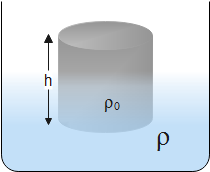
A solid cylinder of density $\rho_0$, cross-section area A and length l floats in a liquid of density $\rho \left( >{{\rho }_{0}} \right)$ with its axis vertical, as shown. If it is slightly displaced downward and released, the time period will be.

A. $2\pi \sqrt{\dfrac{l}{g}}$
B. $2\pi \sqrt{\dfrac{{{\rho }_{0}}l}{\rho g}}$
C. $2\pi \sqrt{\dfrac{\rho l}{{{\rho }_{0}}g}}$
D. $2\pi \sqrt{\dfrac{l}{2g}}$

Answer
557.4k+ views
Hint: Due to difference in pressure at different heights in a fluid, an upward force acts on a body submerged in it which is known as buoyant force. This force is linearly proportional to displaced volume of liquid and its density. Expression of the buoyant force can be used to determine the frequency of the cylinder and therefore, its time period as well.
Complete step by step answer:
When any body is floating in a liquid, it is in equilibrium. At equilibrium the weight of the body is balanced by buoyant force due to the liquid. When it is slightly displaced downward, the upward force on it increases due to increase in buoyant force, for more displacement of liquid. Buoyant force is directly proportional to density of the liquid and volume of the liquid displaced.
${{F}_{b}}=-\rho Vg$
Negative sign here shows that the force is opposite to the direction of displacement. Since, volume of the liquid displaced is equal to the volume of solid cylinder submerged after displacement. Therefore,
$V=Ax$
Substituting this, we have
${{F}_{b}}=-\rho gAx$
This force causes acceleration, in the cylinder, of magnitude
$a=\dfrac{{{F}_{b}}}{M}=\dfrac{-\rho Axg}{M}$
This acceleration is similar to spring force acceleration and can also be written as
$a=-{{\omega }^{2}}x$
Where $\omega =\dfrac{2\pi }{T}$ is the frequency of the solid cylinder. Equating both equations, we have
$-\dfrac{\rho Ag}{M}x=-{{\omega }^{2}}x$
This implies that,
$\omega =\sqrt{\dfrac{\rho Ag}{M}}$
Mass of the cylinder can also be written as $M={{\rho }_{0}}Al$. Substituting,
$\omega =\sqrt{\dfrac{\rho g}{{{\rho }_{0}}l}}$
This implies that,
$T=\dfrac{2\pi }{\omega }=2\pi \sqrt{\dfrac{{{\rho }_{0}}l}{\rho g}}$
Hence, option B is correct.
Note: The buoyant force acts due to difference in pressures at different heights in a fluid. When the object floats on the fluid, it is in equilibrium. If the density of the object is more than the density of the liquid, it sinks in the liquid otherwise not.
Complete step by step answer:
When any body is floating in a liquid, it is in equilibrium. At equilibrium the weight of the body is balanced by buoyant force due to the liquid. When it is slightly displaced downward, the upward force on it increases due to increase in buoyant force, for more displacement of liquid. Buoyant force is directly proportional to density of the liquid and volume of the liquid displaced.
${{F}_{b}}=-\rho Vg$
Negative sign here shows that the force is opposite to the direction of displacement. Since, volume of the liquid displaced is equal to the volume of solid cylinder submerged after displacement. Therefore,
$V=Ax$
Substituting this, we have
${{F}_{b}}=-\rho gAx$
This force causes acceleration, in the cylinder, of magnitude
$a=\dfrac{{{F}_{b}}}{M}=\dfrac{-\rho Axg}{M}$
This acceleration is similar to spring force acceleration and can also be written as
$a=-{{\omega }^{2}}x$
Where $\omega =\dfrac{2\pi }{T}$ is the frequency of the solid cylinder. Equating both equations, we have
$-\dfrac{\rho Ag}{M}x=-{{\omega }^{2}}x$
This implies that,
$\omega =\sqrt{\dfrac{\rho Ag}{M}}$
Mass of the cylinder can also be written as $M={{\rho }_{0}}Al$. Substituting,
$\omega =\sqrt{\dfrac{\rho g}{{{\rho }_{0}}l}}$
This implies that,
$T=\dfrac{2\pi }{\omega }=2\pi \sqrt{\dfrac{{{\rho }_{0}}l}{\rho g}}$
Hence, option B is correct.
Note: The buoyant force acts due to difference in pressures at different heights in a fluid. When the object floats on the fluid, it is in equilibrium. If the density of the object is more than the density of the liquid, it sinks in the liquid otherwise not.
Recently Updated Pages
Why are manures considered better than fertilizers class 11 biology CBSE

Find the coordinates of the midpoint of the line segment class 11 maths CBSE

Distinguish between static friction limiting friction class 11 physics CBSE

The Chairman of the constituent Assembly was A Jawaharlal class 11 social science CBSE

The first National Commission on Labour NCL submitted class 11 social science CBSE

Number of all subshell of n + l 7 is A 4 B 5 C 6 D class 11 chemistry CBSE

Trending doubts
What is meant by exothermic and endothermic reactions class 11 chemistry CBSE

10 examples of friction in our daily life

One Metric ton is equal to kg A 10000 B 1000 C 100 class 11 physics CBSE

1 Quintal is equal to a 110 kg b 10 kg c 100kg d 1000 class 11 physics CBSE

Difference Between Prokaryotic Cells and Eukaryotic Cells

What are Quantum numbers Explain the quantum number class 11 chemistry CBSE




